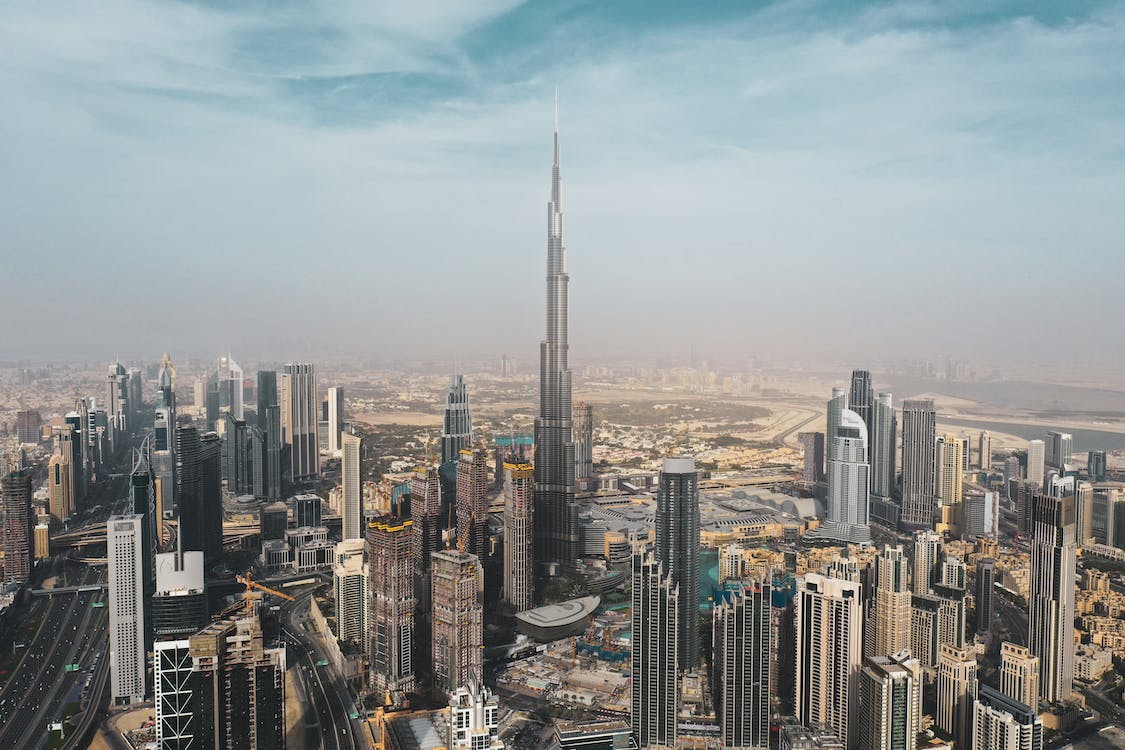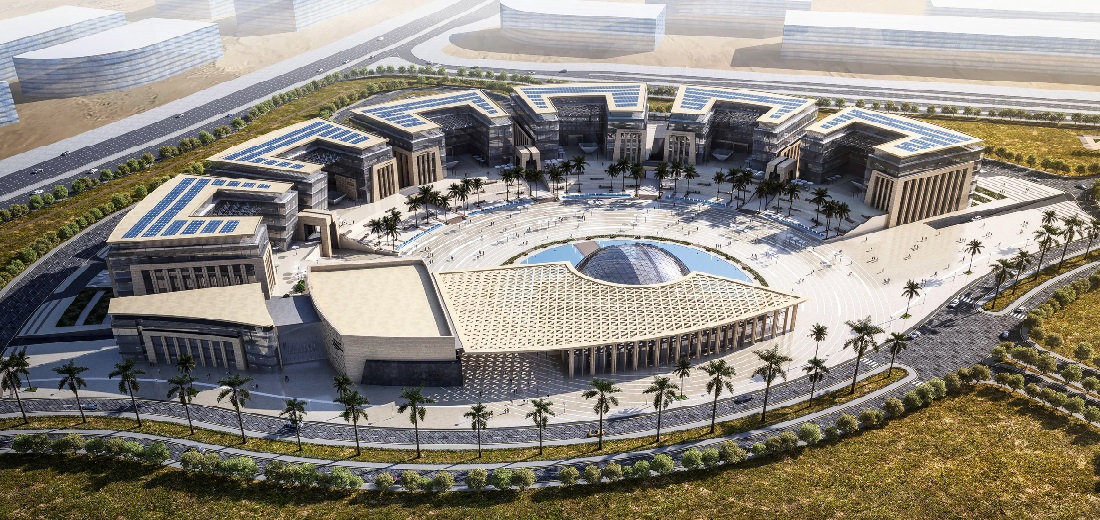Overview of Property Index in Qatar
The property index in Qatar is an essential indicator of the country’s real estate market. It measures the average price changes of residential properties in Qatar. The Ministry of Justice in Qatar calculates the index, which regulates the country’s real estate market.
Here are some key points to keep in mind about the property index in Qatar:
- The index is essential for investors, homebuyers, and real estate professionals to gauge Qatar’s real estate market’s health.
- The property index in Qatar is calculated based on several factors, including supply and demand, legal regulations, and economic conditions.
- The index price-to-income ratio is a valuable metric for understanding the affordability of properties in Qatar. This ratio compares a property’s price to the buyer’s income.
- The COVID-19 epidemic has had a detrimental effect on Qatar’s residential real estate market, causing several residential projects to be postponed or canceled.
- With a market value of USD 4.28 billion this year, residential real estate in Qatar is likely to expand at an annual rate (CAGR) of more than 6.24% in the year of projection.
Historical Development of Real Estate in Qatar
Qatar’s real estate market has undergone significant changes in the past few years, with the 2022 FIFA World Cup being a major driving force behind the sector’s development. The effects of the World Cup and the post-pandemic real estate dynamics in Qatar will be covered in the following subsections.
Impact of the 2022 FIFA World Cup
The Qatari government has invested heavily in infrastructure development and real estate projects to prepare for the 2022 FIFA World Cup. The event has generated a significant demand for real estate, particularly in the hospitality sector. The government has also initiated several large-scale projects, such as the Lusail City development, to accommodate the influx of visitors during the event.
The World Cup has also positively impacted the Qatari economy, with the GDP growing to 4.1% in 2022, up from 1.5% in 2021. The event has created job opportunities and attracted foreign investment, further boosting the real estate sector.
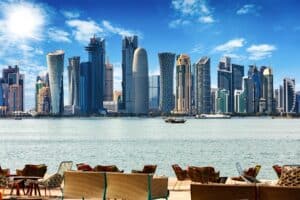
Post-Pandemic Real Estate Dynamics
The COVID-19 pandemic caused several projects to be postponed or canceled, which affected the Qatari real estate market. The real estate price fell by 2.69% in Q1 2023, following a year-over-year growth of 5.09% in Q4 2022 and a loss of 3.86% in Q3 2022. Nevertheless, the market has shown indications of recovery in recent years.
The pandemic has also shifted real estate dynamics, with an increased demand for more significant properties and outdoor spaces. The Qatari government has responded to this trend by initiating several projects that cater to the market’s changing needs.
Summary of Historical Development of Real Estate in Qatar
- The 2022 FIFA World Cup has been a major driving force behind the development of the Qatari real estate market.
- The event has generated a significant demand for real estate, particularly in the hospitality sector.
- The Qatari economy has benefited from the World Cup, with the GDP growing to 4.1% in 2022.
- The pandemic has shifted real estate dynamics, increasing demand for more significant properties and outdoor spaces.
Critical Real Estate Areas in Qatar
Qatar is a country that has been experiencing significant growth in its real estate industry in recent years. The government has a diverse range of properties, from luxurious villas to modern apartments, making it an attractive destination for investors and expats looking for a place to live or invest in. This section will look at some of Qatar’s key real estate areas.
Doha and Its Districts
Doha is the capital city of Qatar and is home to many of the country’s most prestigious properties. The city is divided into several districts, each with its unique characteristics. Some of the most popular districts in Doha include:
- West Bay: This business district of Doha is home to many of the city’s tallest skyscrapers.
- Al Sadd: This is a residential area that is popular with families. The district is known for its tree-lined streets and spacious villas.
- The Pearl: This artificial island was built off the coast of Doha. The area is home to some of the most expensive properties in Qatar and is known for its luxurious lifestyle.
Emerging Regions and Cities
In addition to Doha, several emerging regions and cities in Qatar are worth considering for investment or living. Some of these areas include:
- Lusail: This is a planned city that is being built from scratch. The town is located just north of Doha and will become a significant commercial and residential hub. Lusail is known for its modern architecture and state-of-the-art facilities.
- Al Khor: This is a coastal city that is located in the northern part of Qatar. The area is known for its beautiful beaches and is popular with tourists. Al Khor is also home to several large industrial areas.
- Al Rayyan: This is a rapidly developing area that is located to the west of Doha. The location is known for its large shopping malls and modern residential complexes.
- Umm Salal: This municipality is located in the northeastern part of Qatar. The area is known for its agricultural activities and has several large farms.
In conclusion, Qatar has diverse real estate areas that offer something for everyone. Whether you are looking for a luxurious apartment in Doha or a spacious villa in the suburbs, Qatar has plenty of options.
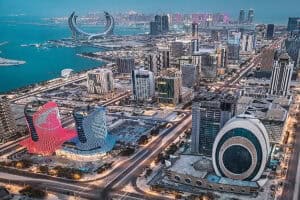
Property Types and Categories
Residential Properties
In Qatar, various residential properties are available for purchase or rent. Some of the most common types of residential properties include apartments, villas, and waterfront properties. Apartments are generally smaller and ideal for individuals or small families. Villas, on the other hand, are larger and offer more space and privacy. Waterfront properties are highly sought after due to their stunning views and proximity to the water.
When it comes to residential properties, there are also different categories that one can consider. For example, there are owner-occupied properties purchased by individuals for their use. Some properties are leased to high-earning senior managers, CEOs, and other professionals. Additionally, there are mini-compounds, a mix of stand-alone waterfront villas, and shared beach access.
Commercial Real Estate
Commercial real estate in Qatar is divided into two categories: office and retail. Businesses typically rent office space for their operations.
Regarding commercial real estate, different types of properties are available. For example, standalone offices and spaces are within more significant commercial buildings. Retail space can include small shops within a mall or large standalone retail stores.
Some additional points to consider regarding property types and categories in Qatar include:
- Residential units in Qatar are often rented fully furnished, making the move-in process more accessible for expats.
- Recent data from the Central Bank of Qatar revealed that in October 2022, Qatar’s real estate price index dropped by 1.8% compared to the year prior.
Real Estate Investment in Qatar
With the recent boom in the real estate market, investors seeking to diversify their portfolios are more drawn to Qatar. Here are some key points to consider when investing in Qatar’s real estate market:
Investor Profiles
- Investors looking for long-term investments with stable returns may find Qatar’s real estate market attractive.
- Those who want to participate in high-risk, high-reward investments may find other markets more appealing.
- Qatar’s real estate market is open to both individual and institutional investors.
Foreign Ownership Laws
- Foreigners are allowed to own real estate in Qatar but must obtain permission from the Ministry of Justice.
- Foreigners are allowed to own property in designated “Investment Areas.”
- In 2018, Qatar passed a law allowing foreigners to own property in more areas of the country, including areas outside of designated Investment Areas.
Budget
- Qatar’s real estate market is known for its luxury properties, but more affordable options are available.
- Investors should consider their budget when looking at properties and determine if they want a short-term or long-term investment.
Foreign Ownership
- Foreigners can own up to 100% of a property in Qatar but must obtain permission from the Ministry of Justice.
- Foreigners are also allowed to lease property for up to 99 years.
Investments
- Qatar’s real estate market has seen significant growth in recent years, but investors should still conduct thorough research before investing.
- When making investment decisions, investors should consider location, property type, and potential rental income.
Permanent Residency
- In January 2020, Qatar announced a new law allowing permanent residency for confident foreign investors.
- To be eligible, investors must meet specific criteria, such as owning property worth at least QR 10 million (approximately $2.75 million) or investing at least QR 10 million in the country.
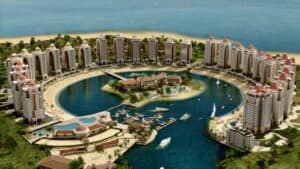
Economic Indicators and Real Estate
GDP and Real Estate Correlation
A country’s GDP is an important economic indicator closely linked to the real estate market. In Qatar, the GDP grew to 4.1% in 2022, up from 1.5% in 2021, partly due to hosting the FIFA World Cup in November and December of 2022. The surge in demand for real estate created during the event led to a return to more normal real estate market conditions in Q1 2023. The Real Estate Pricing Index, which is based on the prices of residential properties, has been steadily increasing since Q1 2012. According to the Qatar Central Bank, the index was 100 in Q1 2009 and reached 218.3 in Q1 2021.
Real Estate and the Qatar Economy
The real estate sector significantly influences Qatar’s economy. The Planning and Statistics Authority estimates that Qatar’s residential real estate market will reach a valuation of USD 4.28 billion in 2024 and grow at an annual growth rate (CAGR) of 6.24% throughout the projection period. The World Bank projects a 3.5% growth rate for the Qatari economy in 2024, compared with the International Monetary Fund’s (IMF) 3.4% prediction. The GCC, of which Qatar is a member, has been attempting to diversify its economy, and as a result, real estate investment has surged.
Some key points to note are:
- The Qatari economy is expected to grow in the coming years, leading to increased demand for real estate.
- The Real Estate Pricing Index has been steadily increasing since Q1 2012.
- The Qatar Central Bank has closely monitored the real estate market and has implemented measures to ensure its stability.
- The GCC countries are working towards economic diversification, which has increased investment in real estate.
Market Analysis and Trends
Price Indices and Ratios
An essential measure of the strength of the real estate sector in Qatar is the property index. Property Finder Qatar reports that after seeing a y-o-y growth of 5.09% in Q4 2022 and a reduction of 3.86% in Q3 2022, the real estate price index decreased by 2.69% in Q1 2023. This suggests a slump in the market, which might be brought on by a glut of available houses and a decline in demand.
The price-to-income ratio is another important metric used to measure the affordability of properties in Qatar. According to the Real Estate Bulletin, Qatar’s price-to-income ratio was 9.2 in 2022. This suggests that properties in Qatar are relatively expensive, which may be due to the country’s high demand for real estate.
Supply and Demand Insights
COVID-19 has impacted the supply of residential stock in Qatar. According to Property Finder Qatar, many projects were delayed or canceled, which has decreased the supply of available properties. This has also affected the rental market in Qatar, with rental prices falling by 5.1% in Q1 2023 compared to the same period in the previous year.
On the other hand, the demand for real estate in Qatar remains strong, particularly in the lead-up to the FIFA World Cup in 2022. According to the Real Estate Bulletin, the number of sale transactions in Qatar increased by 48.6% in 2022, indicating a strong demand for properties in the country.
Regarding mortgage affordability, the loan affordability index in Qatar was 0.3 in 2022, which is lower than the global average of 0.5. This suggests that mortgages in Qatar are relatively affordable, which may be due to the low-interest rates offered by banks in the country.
Overall, the property index in Qatar is an essential indicator of the real estate market’s health. While the market is experiencing a downturn, the country’s strong demand for real estate suggests that the market will likely recover in the long term.
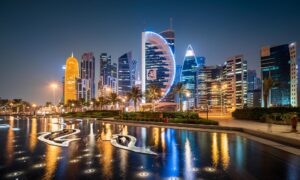
Property Ownership Process
Acquisition Procedures
The property ownership process in Qatar is straightforward and transparent. The Office for Non-Qatari Real Estate Ownership (ONR) oversees the acquisition of real estate by non-Qataris. The ONR works with the Doha Municipality to ensure all regulations are followed, and the acquisition process is completed on time.
To acquire property in Qatar, individuals must follow these steps:
- Obtain a residency permit
- Find a property that meets their needs
- Sign a sales agreement with the seller
- Register the property with the Doha Municipality
The registration process involves paying a registration fee and providing all necessary documentation, including proof of ownership and identification. Once the property is registered, the new owner will receive a certificate of ownership.
Regulatory Framework
The regulatory framework for property ownership in Qatar is based on laws, ministerial decrees, and resolutions dating back to 1963. The general rule is that only Qataris may own freehold estates, while non-Qataris are limited to leasehold estates.
However, non-Qataris are entitled to own real estate under certain conditions. For example, suppose an individual owns a property or multiple properties collectively valued at QAR3,650,000. In that case, they are entitled to all the privileges outlined in Article 7, Paragraph 2 of Council of Minister’s Resolution No. 28 of 2020, about regulating non-Qatari ownership and use of real estate.
The ONR and the Doha Municipality work together to ensure that all regulations are followed and that the property ownership process is transparent and fair. This includes regulating the sale of vacant land to non-Qataris and ensuring all properties are registered with the municipality.
Financing and Affordability
Mortgage and Loan Options
Several mortgage and loan options are available for residents and non-residents when financing a property in Qatar. The mortgage interest rate in Qatar varies according to the lender, but it typically ranges from 3.5% to 5% per annum. The loan affordability index in Qatar is 2.11, indicating that the average resident can afford to buy a property twice their annual income.
Here are some key financing options for buying a property in Qatar:
- Fixed-rate mortgages: These mortgages provide a fixed rate for 20 years. This is a popular option for those who want to know exactly how much they will pay each month and want to avoid any surprises.
- Islamic mortgages: These mortgages are Sharia-compliant and do not charge interest. Instead, the lender earns a profit by buying the property and selling it back to the borrower at a higher price.
- Personal loans: Some banks offer personal loans to finance a property purchase.
Cost of Living and Real Estate Affordability
Qatar is known for its high cost of living, but the real estate affordability index is relatively low compared to other countries. The cost of living in Qatar is influenced by factors such as the high salaries earned by expats and the high demand for luxury goods and services.
Here are some critical real estate affordability metrics for Qatar:
- Rent per month: The average rent for a one-bedroom apartment in the city center is QAR 5,000, while a three-bedroom apartment in the exact location costs around QAR 12,000 monthly.
- Apartment prices: The average price to buy an apartment in the city center is QAR 12,000 per square meter, while the price outside is QAR 8,000 per square meter.
- Salaries and financing: Qatar’s average monthly net salary is QAR 10,000 after tax. With a mortgage interest rate of 4.25% and a 20-year fixed-rate loan, a borrower would need to earn around QAR 25,000 per month to afford a QAR 2 million property.
In conclusion, while the cost of living in Qatar is high, the real estate affordability index is relatively low. With several financing options, residents and non-residents can find a suitable mortgage or loan to finance their property purchase.
Geographical Distribution of Properties
Municipalities and Zones
The property market in Qatar is divided into municipalities and zones, with each zone offering unique characteristics and features. The cities in Qatar include Al Daayen, Al Khor, Al Rayyan, Al Wakrah, Doha, and Umm Salal. Each municipality is further divided into zones, which include popular residential and commercial areas.
Popular Residential and Commercial Areas
Qatar has several popular residential and commercial areas with unique features and characteristics. Some popular residential areas in Qatar include Al Dafna, Al Sadd, Al Waab, Bin Mahmoud, and West Bay. These areas offer many properties, including apartments, villas, and townhouses.
On the other hand, some popular commercial areas in Qatar include the West Bay Business District, the Pearl-Qatar, and the Lusail City. These areas offer commercial properties, including office spaces, retail spaces, and warehouses.
In conclusion, the property market in Qatar is divided into municipalities and zones, with each zone offering unique characteristics and features. The country has several popular residential and commercial areas with distinctive features and characteristics.
Qatar MLS
Qatar MLS is an exceptional platform that fosters connections among real estate professionals and simplifies the discovery of potential clients. As a subsidiary of Arab MLS, it represents the epitome of innovation and excellence in the real estate sector. Subscribing to this platform unlocks unprecedented opportunities and signifies a significant advancement in Qatar’s real estate industry.

Frequently Asked Questions
How has the Qatar property index changed over recent years?
- Throughout the years, there have been changes in the Qatar Property Index. Following a y-o-y gain of 5.09% in Q4 2022 and a fall of 3.86% in Q3 2022, the real estate price index declined by 2.69% in 2023.
- According to the Qatar Central Bank, the indicator consistently increased, rising from about 100 at the start of 2009 to over 300 in late 2015 and early 2016.
What are the current trends in the Qatar real estate market?
- The residential real estate sector in Qatar has been adversely affected by COVID-19. The epidemic caused several home developments to be postponed or canceled.
- With a market value of USD 4.28 billion this year, residential real estate in Qatar is predicted to expand at a growth rate (CAGR) of more than 6.24% in the year of projection.
What factors influence the property prices in Qatar?
- The primary drivers of property prices in Qatar are the country’s high demand for real estate and the scarcity of land and building materials.
- The Qatar Central Bank regulates the property market and has introduced favorable regulations that support the real estate sector.
How does the housing index in Qatar compare to other countries?
- Comparable to other nations in the area, like Saudi Arabia and the UAE, is Qatar’s housing index.
- However, it is essential to note that each country’s housing index is influenced by its unique economic, political, and social factors.
What are the expected returns on real estate investments in Qatar?
- The expected returns on real estate investments in Qatar vary depending on the location and type of property.
- According to industry experts, returns on real estate investments in Qatar are expected to be moderate in the short term but have the potential for significant growth in the long term.
How does the Qatar Central Bank regulate the property market?
- The Qatar Central Bank regulates the property market through the real estate price index, which displays data dating back to mid-2006.
- The bank has introduced regulations that support the real estate sector, such as favorable financing options for homebuyers and developers.





